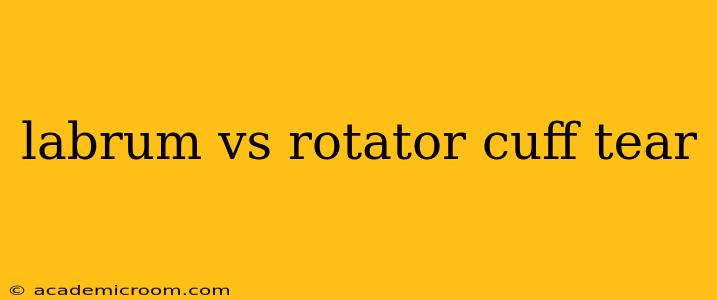Shoulder pain is a common ailment, often stemming from injuries to the labrum or rotator cuff. While both structures are crucial for shoulder stability and function, they are distinct, and understanding their differences is key to proper diagnosis and treatment. This article will delve into the specifics of labral tears versus rotator cuff tears, addressing common questions and misconceptions.
What is a Labrum Tear?
The labrum is a ring of cartilage that lines the shoulder socket, providing stability and depth to the joint. A labral tear is a damage to this cartilage, often caused by sudden movements, repetitive overhead activities, or a fall. The tear can be partial or complete, and its location significantly impacts symptoms. Many athletes, particularly those in throwing sports, are susceptible to labral tears. The most common type is a SLAP (Superior Labrum Anterior to Posterior) lesion, affecting the top portion of the labrum.
What is a Rotator Cuff Tear?
The rotator cuff is a group of four muscles and their tendons that surround the shoulder joint. These muscles—supraspinatus, infraspinatus, teres minor, and subscapularis—work together to allow for a wide range of motion and provide stability. A rotator cuff tear is a damage to one or more of these tendons, often caused by overuse, trauma, or age-related degeneration. Tears can range from small partial tears to large, complete tears.
What are the Symptoms of a Labrum Tear?
Symptoms of a labral tear can vary but often include:
- Clicking or popping in the shoulder: This is a characteristic sign, often felt during movement.
- Shoulder pain: Pain can range from mild to severe, and it may be localized or radiate down the arm.
- Shoulder instability: A feeling of the shoulder "giving way" or "slipping out" is common.
- Limited range of motion: Difficulty with certain movements, such as reaching overhead or behind the back.
What are the Symptoms of a Rotator Cuff Tear?
Symptoms of a rotator cuff tear depend on the severity of the tear:
- Shoulder pain: Often accompanied by weakness and difficulty lifting the arm.
- Weakness: Difficulty lifting or rotating the arm, especially against resistance.
- Limited range of motion: Inability to raise the arm overhead or perform certain movements.
- Night pain: Pain may be particularly noticeable at night.
How are Labrum and Rotator Cuff Tears Diagnosed?
Diagnosis typically involves a physical exam and imaging tests. A doctor will assess your range of motion, strength, and examine for tenderness. Imaging techniques like X-rays, MRI scans, and arthroscopy (a minimally invasive surgical procedure) are often used to confirm the diagnosis and determine the extent of the tear.
How are Labrum and Rotator Cuff Tears Treated?
Treatment options for both labral and rotator cuff tears vary based on the severity of the injury and individual factors. Non-surgical treatments, such as rest, ice, physical therapy, and medication, are often tried first. Surgery may be considered if non-surgical options fail to provide relief or for significant tears. Arthroscopic surgery is a common minimally invasive approach for both labral and rotator cuff repair.
Can you have both a labrum and rotator cuff tear at the same time?
Yes, it is possible to have both a labrum tear and a rotator cuff tear simultaneously. Often, these injuries are related, and the same traumatic event can damage both structures. Accurate diagnosis is crucial to ensure appropriate treatment.
What is the recovery time for a labrum tear vs. a rotator cuff tear?
Recovery time varies significantly depending on the severity of the tear, the type of treatment received (surgical or non-surgical), and individual factors like age and overall health. For minor tears managed conservatively, recovery might take several weeks. More significant tears requiring surgery can involve a much longer recovery period, often spanning several months. Physical therapy plays a critical role in rehabilitation for both types of injuries.
How are Labrum and Rotator Cuff Tears Prevented?
Preventing these injuries involves:
- Proper warm-up before exercise: Preparing your muscles for activity reduces the risk of injury.
- Maintaining good posture: Proper posture reduces strain on the shoulder joint.
- Strengthening the shoulder muscles: Regular exercise strengthens the muscles that support the shoulder.
- Avoiding repetitive overhead motions: Limiting repetitive actions that strain the shoulder can help prevent injury.
This information is for general knowledge and should not be considered medical advice. Always consult with a healthcare professional for diagnosis and treatment of shoulder pain.
